
| Home | About ECA | Activities | Articles | Reviews | Newsletters | Photos | Latest news | Contact us |
The 9th Annual European Cantors Convention
took place from 10th - 14th July 2014 in Budapest, Hungary
Personal refelections
The Cantors Convention in Budapest - Barbara Rosenberg
.
Imagine being together with fifty men who can SING. Beautifully.
In July 2014 I attended the Cantors Convention, held for the first time in Budapest. Fifty chazzanim from the UK, Canada, New York, Israel and Europe attended.
It was a five day course of classes, lectures and masterclasses taught by two masters in the field, Yakov Motzen from Florida and Asher Hainovitz from Jerusalem.
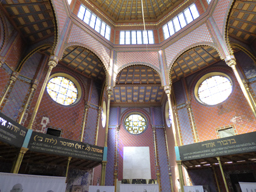 The highlights were definitely the Shabbat services, held in the Rumbach Street Synagogue (pictured, left). Designed in the 1870s it has fallen into disrepair and was opened especially for the convention. Its Moorish style and octagonal shape, with high, high ceilings, gave it the unique acoustics that made the voices resound through the old building, for the first time in over fifty years.
The highlights were definitely the Shabbat services, held in the Rumbach Street Synagogue (pictured, left). Designed in the 1870s it has fallen into disrepair and was opened especially for the convention. Its Moorish style and octagonal shape, with high, high ceilings, gave it the unique acoustics that made the voices resound through the old building, for the first time in over fifty years.
The glorious singing was led by some of the visiting chazzanim, and accompanied by the twenty-strong voices of the Jerusalem Cantors Choir, who joined us for the convention. As someone pointed out, it was worth going for this alone.
A guided tour of Budapest was laid on for the cantors. We learnt that there are an astonishing 80,000 Jews living in Budapest today. We visited some of the splendid Moorish style synagogues, including the Dohany Street Synagogue (below, right), with its breathtaking interior, and boasting 3,500 seats, the largest synagogue in Europe.
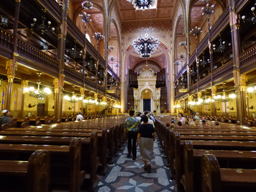 Another highlight of the tour was the stop at the Shoes Memorial, on the banks of the Danube. This is to remember the 60,000 Jews who were ordered to remove their shoes, were then shot and chucked into the river, which became the red Danube that day.
Another highlight of the tour was the stop at the Shoes Memorial, on the banks of the Danube. This is to remember the 60,000 Jews who were ordered to remove their shoes, were then shot and chucked into the river, which became the red Danube that day.
The two guest chazzanim chanted a psalm – ‘Shir Hama’alot’ and the prayer for the dead ‘El Male Rachamim’ and all joined in reciting a heartfelt kaddish which will stay in our memories forever.
The last night concert (below) was THE highlight for me. Some of the Hungarian chazzanim had a chance to sing, plus our two guest teachers, and some of the other professionals, as well as the Jerusalem Cantors Choir in a two hour concert of magnificent singing.
We had some wonderful sessions with demonstrations and talks on the nussach (the traditional chanting) of the High Holy Days – the theme for this year.
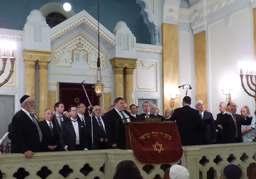 One of the other speakers was a young English chazzan - Yossi Saunders - who won a scholarship through our organization to spend a year at TACI (Tel Aviv Cantorial Institute). His description of their classes made me see why chazzanut is such a highly specialized art form, which only the most musically gifted can perform.
One of the other speakers was a young English chazzan - Yossi Saunders - who won a scholarship through our organization to spend a year at TACI (Tel Aviv Cantorial Institute). His description of their classes made me see why chazzanut is such a highly specialized art form, which only the most musically gifted can perform.
You may well ask what I was doing there. Through my voluntary work with the Jewish Music Institute, it branched off to the ECA (European Cantors Association).
The annual Cantors Convention has previously always been held in the UK. My role is registrations officer, I keep in contact with the delegates prior to the event, and during it provide general hospitality and ‘mommy-ing’.
The reason I choose to do this is to be witness to the passion and love this art form holds by all attendees. To be in a room with fifty men who spontaneously provide a choir, humming a backing in harmony to any soloist, I find thrilling, and totally outside of my normal experience.
I marvel at the fact that when a recording of an old master is played, there are always a number of people who recognise his voice, instantly.
Chazzanut has such an important place in their lives, both those who are professional or those who just love it. I feel privileged to be part of it in some small way. I could go into further raptures, but anyone who would like to know more, just contact me and I’ll be happy to oblige.
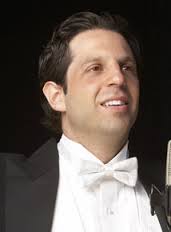 Sitting By The Shore of The Danube - Cantor Eric Moses
Sitting By The Shore of The Danube - Cantor Eric Moses
I write this message to you as I sit at the airport in Budapest...a once thriving hub of Jewish life in Eastern Europe. Today it is home to nearly 100,000 Jews, many unaffiliated and unaware of their Jewish roots.
Four decades of communism following the massacres of WWII by the Nazis and Arrow Cross have left a challenging new normal for Hungary's Jewish community. I visited Hungary as my synagogue's representative at the European Cantor's Association annual convention. For the first time since the Holocaust, this gathering of cantors from around the world was held in Hungary. It was a four day journey packed with emotion, history and beauty.
The synagogues in Budapest are without question among the most spectacular I have seen anywhere. While most were expropriated by the former communist government, the Jewish community has managed to have them returned as long as they can show that the buildings will be utilized.
Although there are more synagogues than people to populate them, they offer occasional services at the lesser used buildings to show that they are a required asset to the community.
Jewish life in Hungary is complicated (to say the least)! For example, one of the cantors explained to me that the city has three different kashrut organizations for only two functioning kosher restaurants. To make matters more ridiculous, of the the two kosher restaurants, he is only permitted to eat at one of them due to political reasons.
There is no question that anyone who has travelled to Eastern Europe has witnessed first hand how different it is to be a Jew there today. However, in defence of the Jews living in Budapest, they are passionately Jewish and still proudly Hungarian.
When I arrived at the conference's host synagogue, I was greeted by a tough looking security guard covered in tattoos on his right arm. I politely asked in English if this was the synagogue and he responded in beautiful Hebrew words of welcome - he was Israeli. He also advised me not to wear my kippah on the street.
When our group was taken on a Jewish tour of Budapest, we were accompanied by two Israeli security guards and two Hungarian police officers. One of the great differences between the Europe of today and that of 1945 is the State of Israel.
The birth of a Jewish state has burdened us with all of the challenges of any democratic nation. However, it has also given us the necessary resources, courage and military might to look after ourselves, be it at home or abroad.
As I write this article, Israel is in the midst of Operation Protective Edge - trying to stabilize an impossible situation in Gaza while at the same time protecting Israeli citizens and minimizing Palestinian casualties. In the world of public opinion, Israel is continuously defending its policies and defence tactics.
As I spent time in Budapest trying to process why Jews continue to live there, I drew comfort from the fact that Israel is still our refuge. At any given moment, the tides can turn and Jewish people have where to go. Israeli courage and determination has redefinied a different type of Jew - strong, proud and able to fend for themselves.
Sitting in the old abandoned Rumbach Shul on Shabbat, the convention organizers chose this venue for Shabbat services. On display was a beautiful life sized image of what was once a stunning synagogue in the heart of the Jewish quarter.
For the first time since WWII, the synagogue was open for prayer. They brought in plastic chairs and a portable Aron kodesh so that Shabbat could be observed in the same manner of its former splendour. Our voices echoed through the walls of this once magnificent synagogue.
As Hazzan Motzen led us in the prayer for the State of Israel and the Mi Sheberach for the IDF soldiers positioned on the front lines, the feeling of pride was palbable. Jewish life will never be as it once was in Hungary but the Jewish community continues to rebuild and reshape Jewish life. While this old building may have been in tatters, a new generation in Israel was growing, building and fighting for a better and brighter tomorrow.
Am Yisrael Chai
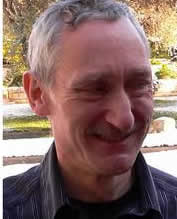 So what is the longest Friday night service you could imagine? - Hirsh Cashdan
So what is the longest Friday night service you could imagine? - Hirsh Cashdan
So what is the longest Friday night service you could imagine? (Here’s a clue, we never exceed an hour at Richmond).
Recently I enjoyed a full 2 hours – but it was a special occasion. This was in Budapest as part of the 2014 European Cantors Convention attended actually by participants from USA, Canada and Israel as well as the UK and other European Countries.
Budapest is a beautiful city, once two cities with Pest and Buda linked by bridges over the Danube. The Jewish community, amazingly some 80,000 strong is mostly in Pest where the metropolitan centre of the unified city is located and boasts some wonderful synagogues. We sampled 4 of them.
The convention sessions and the two concerts took place in Bethlen Square Synagogue - a pleasant shul half an hour’s walk from the central area. Here we focused on helping prepare delegates for the forthcoming High Holy days with the expert help of two world famous guest chazzanim – Asher Hainowitz of the Yeshurun Synagogue in Jerusalem and Yaakov Motzen from Florida.
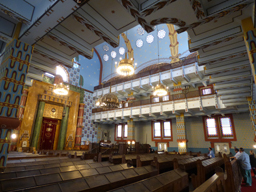 They provided many examples of ways of tackling the nusach (traditional chanting) of Rosh Hashanah and Yom Kippur while keeping the interest of the congregation engaged and encouraging them to join in well known melodies. Local speakers introduced us to the specific heritage of Hungarian chazzanut and many other related topics were also included.
They provided many examples of ways of tackling the nusach (traditional chanting) of Rosh Hashanah and Yom Kippur while keeping the interest of the congregation engaged and encouraging them to join in well known melodies. Local speakers introduced us to the specific heritage of Hungarian chazzanut and many other related topics were also included.
All of this was folded round a Shabbat enhanced not only by the singing of various of the chazzanim but also by 20 members of the Jerusalem Cantors Choir who were not only participants but “took over” Kabbalat Shabbat singing an elaborate arrangement to virtually every paragraph – that and the 4 speeches of welcome all of which had to be retranslated into either Hungarian or English accounted for the length of the service.
Our Shabbat services were mostly at the Rumbach Synagogue – a wonderfully decorated octagonal building which had lain empty for 50 years but was recommissioned especially for us and didn’t we bring it back to life resoundingly! We did however hold Minchah on Shabbat afternoon at another strikingly beautiful and capacious synagogue nearby – the Kazinczy Synagogue (above, right)– remarkable not only for its decoration but also for its two tiers of ladies seating.
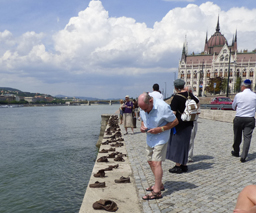 On the Sunday afternoon we were treated to a tour of Budapest and given the opportunity to return to the various synagogues armed with camera (hence these photos). Apart from the ones I have mentioned we of course also visited the largest and most famous of all the Budapest shuls – Dohany Street. This is huge with space for a mere 3,500 people but very good acoustics – Lazlo Fekete, the home chazzan, proved it to us by standing in front of the Aron Kodesh and singing a piece for us – it could be heard everywhere …mind you he does have a very loud and penetrating voice!
On the Sunday afternoon we were treated to a tour of Budapest and given the opportunity to return to the various synagogues armed with camera (hence these photos). Apart from the ones I have mentioned we of course also visited the largest and most famous of all the Budapest shuls – Dohany Street. This is huge with space for a mere 3,500 people but very good acoustics – Lazlo Fekete, the home chazzan, proved it to us by standing in front of the Aron Kodesh and singing a piece for us – it could be heard everywhere …mind you he does have a very loud and penetrating voice!
Extremely moving was a visit to the Shoe Memorial (left). Situated just outside the Hungarian Parliament, on the edge of the bank of the Danube, this commemorates the shooting and dumping into the Danube of a number of Jews in 1944. To stand there while two great chazzanim led us in reciting psalms, a memorial prayer for the dead and kaddish was indeed a highlight of the tour.
My role on the convention was to manage the programme and keep order – not always an easy task particularly in a foreign country with highly varied and special participants! The convention is run by the ECA (European Cantors Association) - if anybody fancies tackling my role next year you can apply to the ECA - http://www.cantors.eu/ but if you’re hoping for an even more exotic location I have to disappoint you … next year the plan is to hold the convention in Leeds.
Hirsh Cashdan
Updated 24th August 2014
